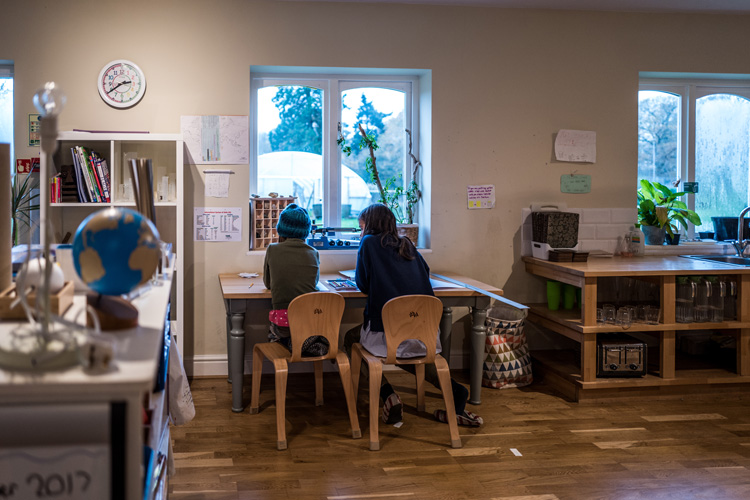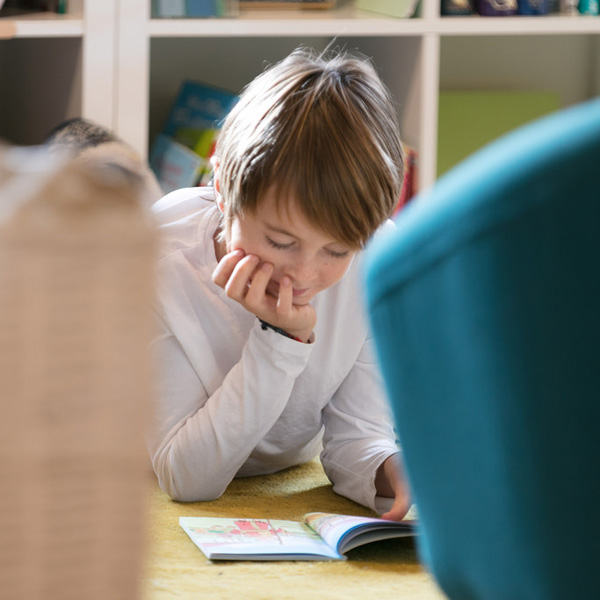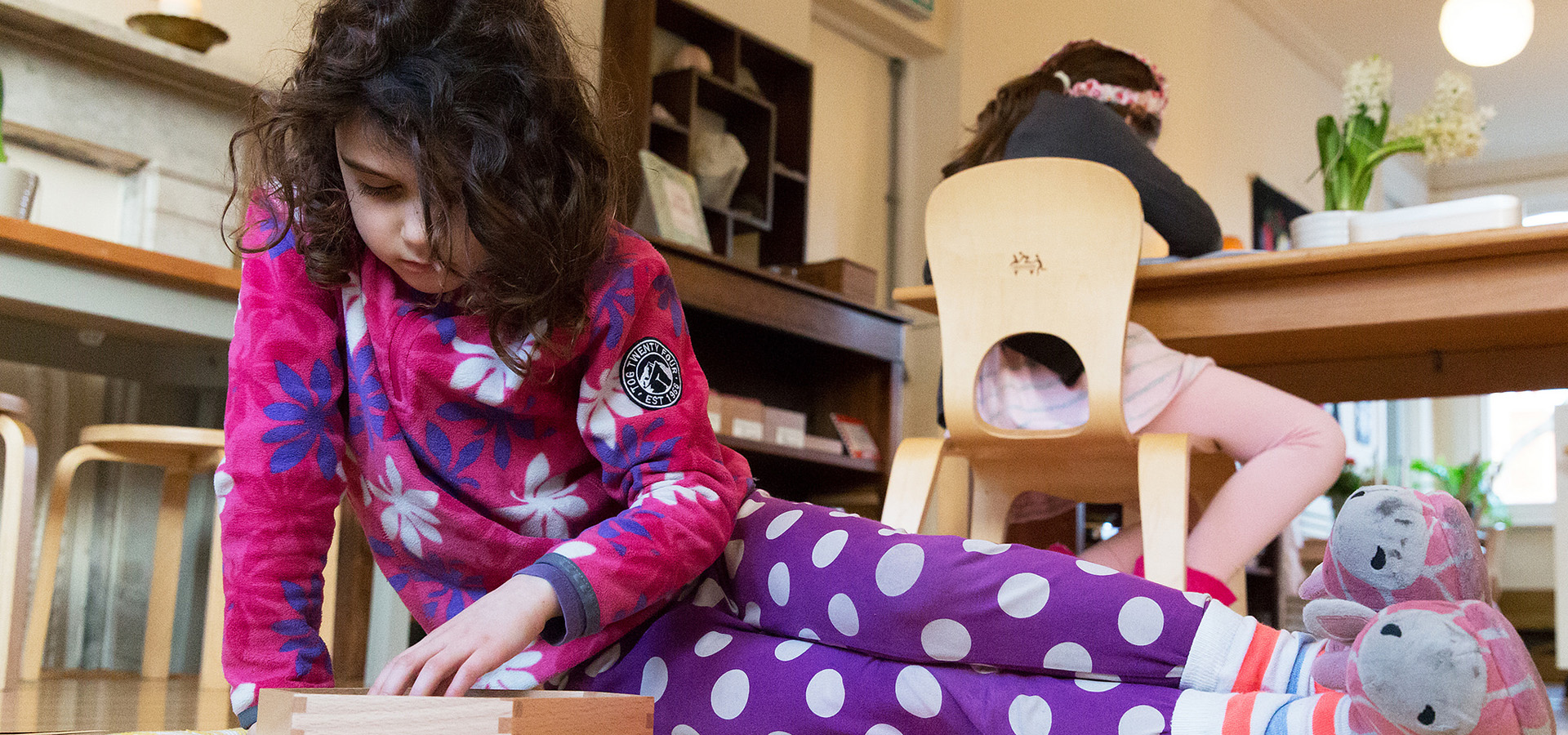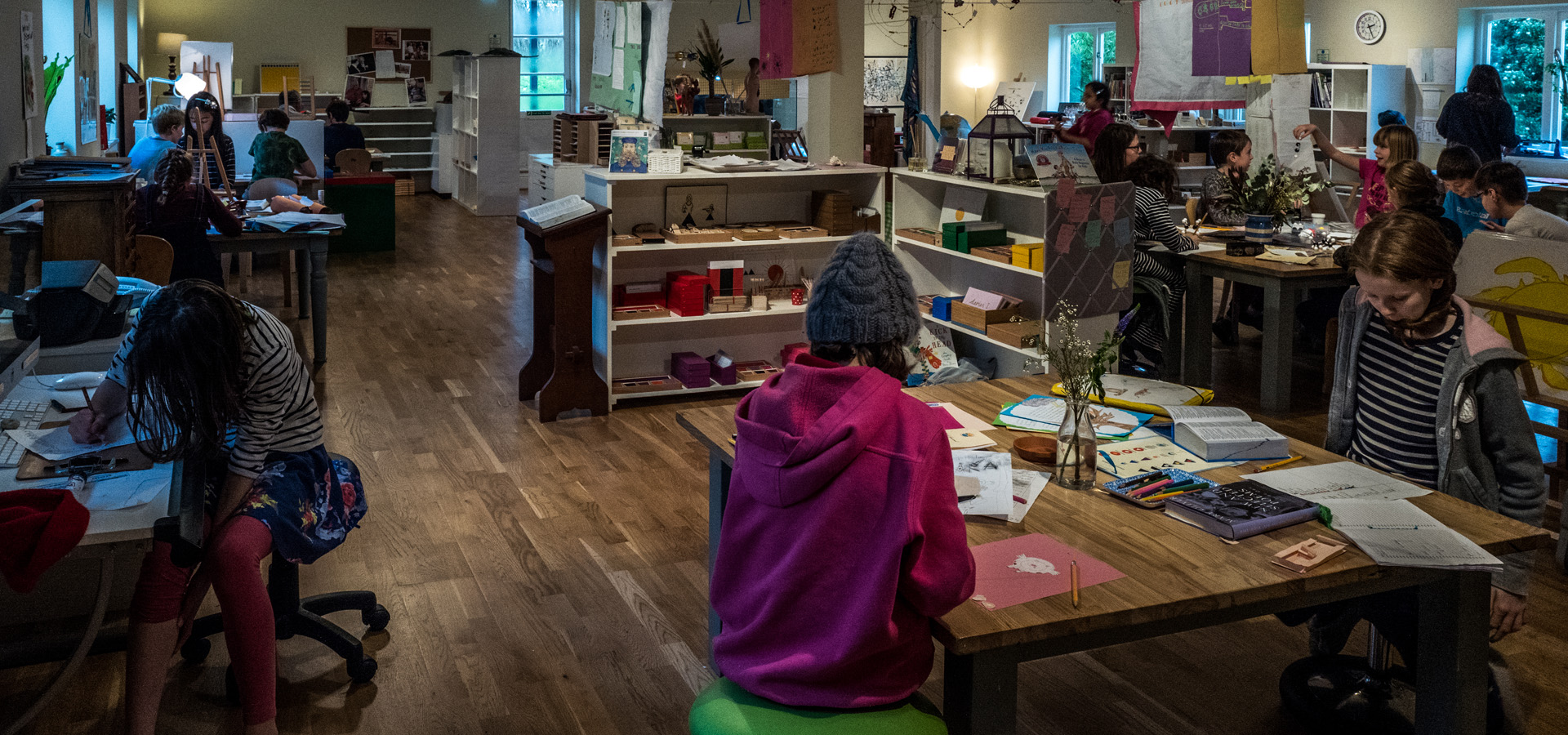AGES 6-12
"The secret of good teaching is to regard the child’s intelligence as a fertile field in which seeds may be sown, to grow under the heat of flaming imagination. Our aim therefore is not merely to make the child understand, and still less to force him to memorize, but so to tough his imagination as to enthuse him to his inmost core."
Maria Montessori, 'To Educate The Human Potential'.
The Montessori Place Elementary is a place of superlatives. In their own words, it is a place where children seek to become the kindest, smartest and most skilful people they can.
It is a place brimming with ideas and a place bubbling with action. It is a place where children organise first aid training for their class, arrange their own visits to museums, archaeological sites, zoos and theatres. It is a place where children choose to graph river discharge against length, recreate Giacometti sculptures, identify and tag dozens of woodland trees, write political manifestos and calculate the square roots of country populations. It’s a place where there are no fixed lesson times, no set assignments and no formal testing.

There is an Elementary Community at each of our two sites, one in Hove and one at our new Lewes site at Eason’s Green. At both sites the Elementary rooms are beautiful, inspiring spaces that offers thousands of opportunities to connect to the world and the universe. The bright and spacious rooms are carefully prepared to meet all of the child’s developmental needs, and are set up to support maximum independence practically, socially and academically.
At both sites, light floods in through large windows facing all aspects. Uncluttered walls are hung with original paintings from a variety of periods. An eclectic mix of modern and antique wooden tables and chairs are spaced out around room, while shelves are filled with materials that call the child to all aspects of culture.
Read more
At The Montessori Place we understand that we can’t directly transfer knowledge, that instead each child learns through their own efforts and at their own pace. Rob (at Eason’s Green) and Pete (in Hove) give lessons, tells stories and offers instruction, but learning takes place when the child is working; perhaps discovering the process of long division using the Test Tube Division material, studying the differences between flower types or discussing with a friend the reasons why a civilisation arose in a particular time or place. Our priority is to give a lesson in how to do use a material or carry out a task, connecting the child to the environment so they can explore culture with increasing independence.
For the Elementary child, the world beyond the main room also has many places we prepare for them to use. In Hove, the building as a whole – the Infant Community, Children’s House, kitchen, Family Room, office and garden are all part of the prepared environment for the Elementary Community children. A child’s foray beyond the class may be to help the Infant Community children get dressed to go home, to record bee movements in a patch of the garden, to give a presentation to the children in the Children’s House or to collect food waste from the kitchen to put in the wormery.
At Eason’s Green the neighbouring communities of the Children’s House and Young Peoples’ Community are frequently visited by the Elementary children. So to are the woodlands and grounds that surround the Eason’s Green Elementary. Here the Elementary opens onto ancient woodland on one side and the horticultural garden on the other. These environs are as familiar to them as the main classroom.
Read less
When they arrive at the start of the day, many children already have a clear idea of what they intend to work on and get straight on with it. This is worth repeating: many children come in and start their work without any intervention or direction from their Guide. Often little conversations take place in the cloakroom between two or more children as they put on their indoor shoes, ‘Shall we do the Verb Grammar Box together?’ or ‘Do you want to carry on our rivers research?’
As working groups establish themselves at the start of the day, the children also look to see what presentations (lessons) they have that day. These are not scheduled for particular times. The timing of them is chosen by the Guide and is flexible to allow children are already deeply engaged to continue uninterrupted.
In a mixed-age community of around 30 children the Guide will likely have half a dozen quick conversations with those that need more support to get started, before gathering a small group for the first presentation of the day. Today that presentation is ‘Squaring a Sum’. The children fetch the materials the Guide needs from the shelf and gather around. Meanwhile the 25 other children work independently in small groups or individually. The 15-20 minute lesson is given, showing the children how to use the materials. The children understand that, once shown, their job is to use the materials to get really good at – in this instance – squaring a sum. At the end of the presentation 3 of the children start working on squaring a sum, others take out other work, and will come back to the maths material another time.
Read more
Meanwhile, three children started the morning continuing their work making paper. They have previously made a deckle and frame, and are now creating the pulp. Four others are using the History Question Charts to guide their comparative study of cultures in 3000 BCE, exploring the Sumerians, Egyptians and Neolithic Britain.
Nearby, an older child is spell-checking a story a younger child has just finished, offering positive comments about a character. At the same table two girls and a boy are labelling the Trinomial Cube with algebraic labels for each piece – a3, a2b etc. A small group of 4 children have hung their nametags on the board to say they have gone across the courtyard into the North Woods. They are looking for dry and succulent fruits, following on from a presentation the previous day.
Two children are reading on the sofa. Occasionally they share a sentence from the book they are reading that they think is funny. They are not disturbed by the sound of the tone bars a few metres away. Three children have invented a game to learn the note names. One of them plays a note (as part of a scale) and, without looking, the other two have to say the name of it. They giggle a little as they hide their faces to prove they are not looking.
One child is weighing a bearded dragon. When she has recorded its weight, she returns it and takes out the next animal. She is graphing their weights as a way of monitoring their health. Her friend invites her to join a group trying to classify all the species of the order cetacea.
Some of these activities may carry on for the whole morning, others – such as reading a book – may finish more quickly and other work then found. There is a flow and hum to the environment, much like that of an open plan office. Having completed the first presentation, the Guide may invite one or two children to get ready for One-to-One meetings, where the guide meets with them to review their week. The Guide asks what the child is most proud of this week. They look at the work together; discuss what is going well and anything that is proving difficult. Depending on the child, the Guide may ask what their plan is for the coming week, or agree clear goals for them.
The morning unfolds with this great variety of work interspersed with presentations by the Guide, One to One meetings and the myriad of other questions and conversations that make up Elementary community life.
At 11.45 a child rings the singing bowl to get everyone’s attention. Three children are about to present to the class their work calculating the volumes of all the planets in the solar system.
At 12pm one of the older children dismisses the children to lunch, asking them to name animals beginning with a particular letter in order to leave to wash their hands. The children lay the table, serve each other and wash up afterwards before heading into the courtyard or woods for ‘garden time’.
The afternoon unfolds in a similar way, perhaps with some singing or other short group at the beginning. At the end of the afternoon work-cycle the children complete their community job, tidying the room and caring for the plants and animals before they all settle down for ‘Read Aloud’ when the Guide reads to them for 20-30 minutes.
Read less
In the second plane of development (6-12 years) children quickly develop considerable physical strength and stamina and a intellectual curiosity about the functioning of the society around them. In development terms, nature and endowed them with the physical and intellectual means to explore beyond the four walls of a classroom. We support them in this quest, helping them little by little and step by step to plan and carryout out these forays into society, which we simply call ‘Going Out’.
“The foot is noble. To walk is noble. Thanks to the feet, the child who already walks can expect of the outdoors certain answers to his secret questions.”
-Dr. Maria Montessori
The first instinct of the young Elementary child, when then want to go out, is to open the door and go. Whether the goal is to buy fruit or flowers, or visit the library, park or woodland, the 6 or 7 year old needs support to plan what is needed and establish exactly where they need to get to. Money, maps, coats and the plans of others all need to be considered. Whereas in the first plane we help the child to act for themselves, now we help them to think for themselves, working out what they need in order to be safe and successful.
As the children get older, they arrange more complex visits which are likely to involve phone calls and internet searches are part of the process. These ‘Going Outs’ eventually extend into overnight visits, for example to see a Shakespeare play at Stratford upon Avon or to visit the Neolithic sites in Orkney.
Unlike traditional class trips, these visits are organised by the children and follow interests that they have. They are not ‘taken’ by the adult, instead they lead and an adult chaperones them.
“In this intellectual period, the child’s questions are innumerable. He wants to know everything. His thirst for knowledge is so insatiable that, generally, people are at their wits’ end about it; therefore, they most(ly) choose the easiest way and simply force the child to be silent, and to learn only what we grown-ups consider useful for him. But, in doing so, we also destroy his spontaneous interest. Learning then becomes a tedious and tiresome business. The result is all sorts of deviations in the child’s personality.”
It should be realized that genuine interest cannot be forced. Therefore, all methods of education, based on centres of interest, which have been chosen by adults, are wrong. Moreover, these centres of interest are superfluous, for the child is interested in everything… A global vision of cosmic events fascinates the child and his interest will soon remain fixed on one particular part, as a starting point for more intensive studies. As all parts are related, they will be scrutinized sooner or later. Thus the way leads from the whole via the parts back to the whole.
Thus the child will develop a kind of philosophy which teaches him the unity of the universe. This is the very thing to organize his intelligence and give him a better insight.”
Maria Montessori, unpublished lecture, University of Amsterdam, 1950
Dr Maria Montessori described the type of education that Elementary-aged children need as ‘cosmic’. The quote above is from 1950, so a little before the 60’s gave the word a different meaning. She was referring to the Greek root of the word ‘cosmos’ meaning the world or universe as a complete harmonious system. Her insight was to offer the emerging intelligence of the 6-12 year old a holistic framework for at the beginning of their education, rather than at offering fragments of knowledge to be pieced together in maturity. From the whole to the parts rather than the parts to the whole.
Read more
- 1st Great Story – The Formation of the Universe: The first story starts with the expansion of the Universe and ends with the formation of the Earth
- 2nd Great Story – The Coming of Life: The second story starts with water on the surface of the Earth, and tells how life appeared, gradually gaining in complexity until the Earth was finally ready for a special creature…
- 3rd Great Story – The Story of Humans: The third story introduces this creature with three special gifts; a mind that can imagine, hands that can work and a heart that can love.
- 4th Great Story – The Story of Communication through Signs: The forth and fifth stories are about the two great inventions of human beings; written language and numbers. The forth tells of the first marks and signs people would leave as messages before following the journey from the Egyptians through the Phoenicians, Greeks and Romans to the writing we use today.
- 5th Great Story – The Story of Numbers: Similarly to writing, we tell of the universality of number systems and the various civilisations we have to thank for our number system.
These stories are repeated once or twice a year, and children often come back to hear them again and again. Aside from offering a simple dramatic narrative to explain how things got to be the way they are today, the stories emphasise gratitude. Gratitude for the nameless people that went before us inventing the tools we take for granted today, gratitude for the unconscious service given by animals and plants one to another that makes it possible for life to continue, and a general sense of awe and the harmony and interconnectedness that exists between all things.
The stories open up the study of the Earth, life and the human story. They put into context the child’s work in maths and language. Each story is the starting point for the subjects of physics, chemistry, geography, biology, history, art, music, languages, geometry and maths. A growing complexity is offered in each of these areas, but always with the possibility, for example, of geography work morphing into biology, or maths becoming history.
Read less

The Psychology
Understand this stage of development
Only through freedom and environmental experience is it practically possible for human development to occur.
MARIA MONTESSORI





